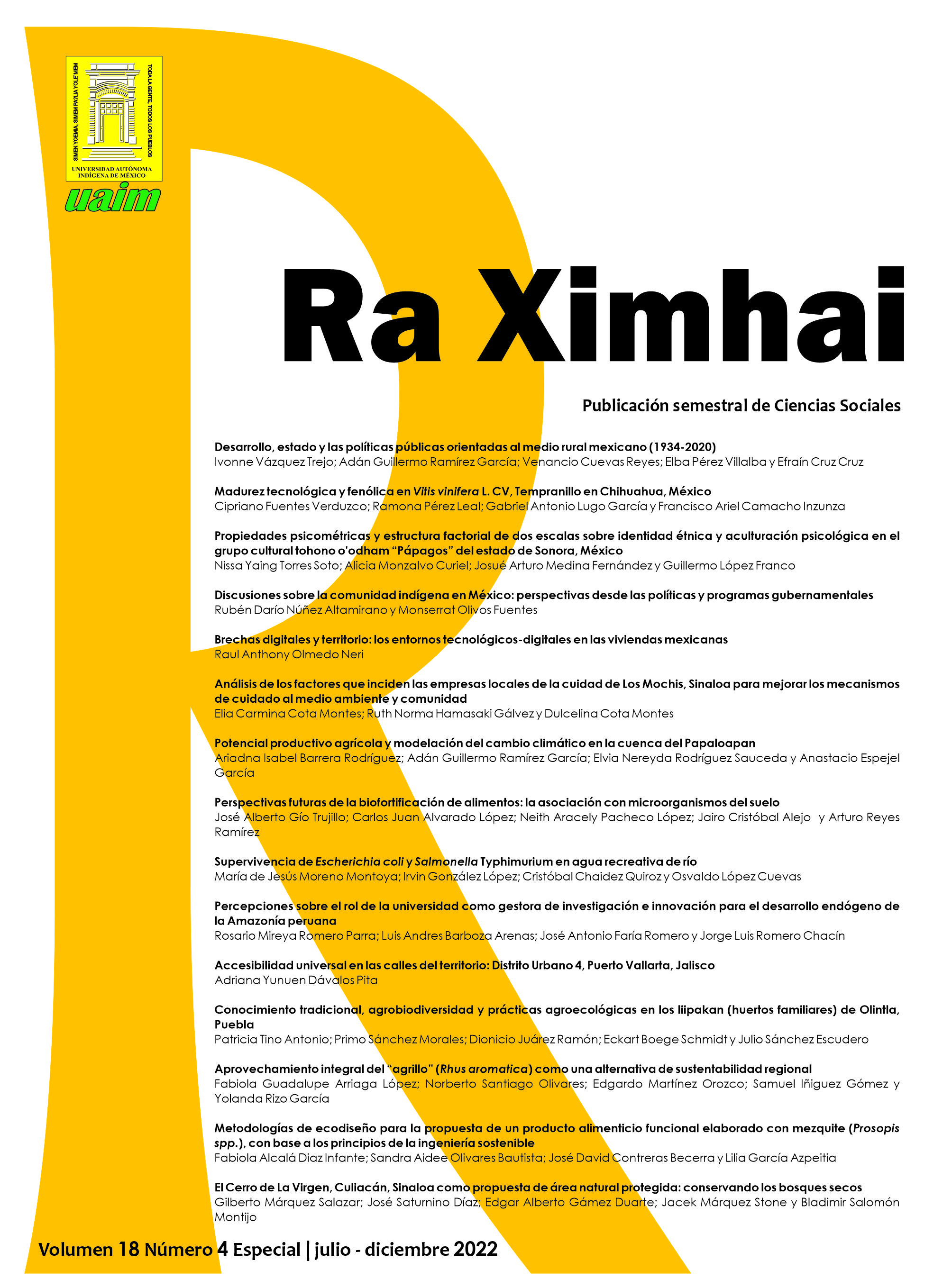Accesibilidad universal en las calles del territorio: distrito urbano 4, Puerto Vallarta, Jalisco
DOI:
https://doi.org/10.35197/rx.18.04.2022.11.adPalabras clave:
ciudad, inclusión social, derecho a la ciudad, sustentabilidad, calidad de vida, diseño universalResumen
Dentro de los Objetivos de Desarrollo Sustentable, podemos encontrar en el Objetivo 11 la relación con la accesibilidad universal, el cual persigue la meta de que, dentro de la ciudad, cualquier individuo pueda disfrutar de los espacios públicos, atendiendo particularmente las necesidades de: personas con discapacidad, adultos mayores, mujeres, niños. Siendo este un punto muy importante a atender en la transformación de las ciudades hacia la sustentabilidad.
El presente estudio tiene como objetivo “Identificar las áreas de oportunidad que existen dentro del territorio a partir de la relación de las variables”. Se analizaron variables que tienen que ver con la accesibilidad universal en la vialidad, estas variables fueron tomadas de la plataforma interactiva Espacio y Datos de INEGI y fueron evaluados en campo según los criterios de la accesibilidad universal.
La investigación es de tipo correlacional, diseño descriptivo, con un enfoque cuantitativo, efectuando trabajo de campo y el análisis de datos estadísticos por medio de software SPSS (versión 25) y una muestra conformada por 1,414 Manzanas. Los resultados revelan que se rechaza la hipótesis 1: La fuente con mejores índices de accesibilidad universal son los detectados en INEGI, así como la hipótesis 2: Existe relación significativa entre todas las variables de accesibilidad universal en el distrito 4 de Puerto Vallarta, se rechaza al no presentarse en la totalidad relación significativa.
Descargas
Citas
Campos y Covarrubias, G., & Lule Martínez, N. E. (2012). La observación, un método para el estudio de la realidad. Xihmai, VII(13), 45-60.
Comisión Económica para América Latina y el Caribe. (12 de Diciembre de 2018). CEPAL . Obtenido de CEPAL : https://www.cepal.org/es/enfoques/inclusion-social-economica-politica-personas-mayores
Confederación Española de Personas con Discapacidad Física y Orgánica. (s.f.). Observatorio Accesibilidad y Vida Independiente . Obtenido de Observatorio Accesibilidad y Vida Independiente : https://observatoriodelaaccesibilidad.es/archivos/3104
Fernández, J. d., García Milá, J., Juncà Ubierna, J. A., de Rojas Torralba, C., & Santos Guerras, J. J. (2010). Manual para un entorno accesible. Madrid: Real Patronato sobre Discapacidad, con la colaboración de la Fundación ACS. Recuperado el 5 de Marzo de 2017, de http://www.includ-ed.eu/sites/default/files/documents/realpatronato.manual_entorno_accesible.pdf
Gobierno de Puerto Vallarta, Jalisco. (24 de Diciembre de 2020). Gobierno de Puerto Vallarta, Jalisco. Recuperado el 21 de Agosto de 2021, de Gobierno de Puerto Vallarta, Jalisco.: https://transparencia.puertovallarta.gob.mx/gacetas/2018-2021/Gaceta%2018%20T02%20WEB.pdf
Gutiérrez Brezmes, J. L. (25 de Septiembre de 2012). Universidad Iberoamericana . Obtenido de http://campusverde.ibero.mx/otros/foro-sistemas-manejo-ambiental/presentaciones/2-j-l-gutierrez-brezmes.pdf
Hernández Galán, J. (2011). Accesibilidad Universal y Diseño para Todos. Arquitectura y Urbanismo. (1° ed.). España: Fundación ONCE/Vía Libre.
Instituto Nacional de Estadística y Geografía. (s.f.). Espacio y Datos de México. Recuperado el 15 de 01 de 2022, de http://www.beta.inegi.org.mx/app/mapa/espacioydatos/
López Catalán , M., Quesada Molina, F., Guillem Mena, V., Orellana Valdez, D., & Serrano , A. (2015). La accesibilidad en la vivienda sustentable. Estudios sobre Arte Actual.
Luna Parra, M. A. (2002). Ciudades humanas. En Ciudades humanas. Pobreza urbana y el futuro de las ciudades. (Primera ed., págs. 93-104). México: Gobierno del Estado de México.
Mejia Jervis, T. (04 de Mayo de 2017). Lifeder. Recuperado el 22 de Marzo de 22, de https://www.lifeder.com/investigacion-correlacional/
ONU-Habitat. (24 de Febrero de 2020). ONU-Habitat. Obtenido de ONU-Habitat: https://onuhabitat.org.mx/index.php/componentes-del-derecho-a-la-ciudad#:~:text=El%20Derecho%20a%20la%20Ciudad,comunes%20para%20una%20vida%20digna.
Pita Fernández, S., & Pértegas Díaz, S. (27 de 05 de 2002). Instituto Tecnológico y de Estudios Superiores de Monterrey . Obtenido de https://homepage.cem.itesm.mx/amaya.arribas/diferenciascualti-cuant.pdf
Secretaría de Desarrollo Agrario, Territorial y Urbano. (24 de 10 de 2016). Gobierno de México . Obtenido de https://www.gob.mx/sedatu/prensa/derecho-a-la-ciudad-accesibilidad-universal-y-enfoque-de-genero-aportaciones-de-mexico-a-la-nueva-agenda-urbana?idiom=es-MX
Secretaría de Desarrollo Agrario, Territorial y Urbano. (2019). Manual de calles. Diseño vial para calles mexicanas. Ciudad de México, México. Obtenido de https://www.gob.mx/sedatu/documentos/manual-de-calles-diseno-vial-para-ciudades-mexicanas
Universidad Nacional Autónoma de México. (2017). Ciudades sostenibles y derechos humanos. Ciudad de México, México: Universidad Nacional Autónoma de México. Obtenido de http://www.cndh.org.mx/sites/all/doc/OtrosDocumentos/Doc_2017_033.pdf
Descargas
Publicado
Cómo citar
Número
Sección
Licencia
Derechos de autor 2022 Adriana Yunuen Dávalos Pita

Esta obra está bajo una licencia internacional Creative Commons Atribución-NoComercial 4.0.
Usted es libre de:
- Compartir — copiar y redistribuir el material en cualquier medio o formato
- Adaptar — remezclar, transformar y construir a partir del material
- La licenciante no puede revocar estas libertades en tanto usted siga los términos de la licencia
Bajo los siguientes términos:
- Atribución — Usted debe dar crédito de manera adecuada , brindar un enlace a la licencia, e indicar si se han realizado cambios . Puede hacerlo en cualquier forma razonable, pero no de forma tal que sugiera que usted o su uso tienen el apoyo de la licenciante.
- NoComercial — Usted no puede hacer uso del material con propósitos comerciales .
- No hay restricciones adicionales — No puede aplicar términos legales ni medidas tecnológicas que restrinjan legalmente a otras a hacer cualquier uso permitido por la licencia.








